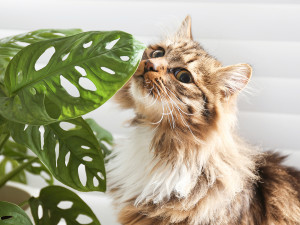5 Plants That Are Toxic to Your Dog
Thriving plants are spring’s whole thing—but these offenders can be perilous to pets.

Share Article
Spring is the time for your houseplants to shine. Whether as a way to connect to nature, to give ourselves the meditative sense of purpose that plant care provides, or simply because leaves of all shapes and sizes look so sculptural and alluring on Instagram, we simply cannot get enough indoor greenery.
When selecting your next photosynthesizing friend, however, it’s important to remember that some plants can be perilous to pets — especially to dogs who tend to snuffle up fallen leaves or gnaw on branches as if they were chew toys. Most of us are unlikely to have extremely poisonous plants growing in our living rooms — like, say, hemlock or mistletoe — but there are a number of common houseplants that can have toxic effects when consumed by a grazing canine. Below are five of the biggest offenders to avoid.
Pothos
One of the most popular houseplants around, pothos — also known as “devil’s ivy” — boasts pretty, heart-shaped leaves, and is often seen trailing out of hanging baskets. Unfortunately, its leaves contain tiny calcium oxalate crystals, which can irritate a dog’s mouth if ingested, causing burning and swelling of the tongue (a telltale sign would be excessive drooling or pawing at the mouth).
Note: These crystals are can be found in philodendrons and dieffenbachia, or “dumb cane,” which should also be skipped by pet parents.

Peace lily
A plant that’s often sold in grocery stores, peace lilies are celebrated for their ability to grow in very low light and filter out pollutants from indoor air. However, buyer beware: The flower’s pollen can be an irritant, and the leaves, flowers, and stems contain calcium oxalate, which is toxic to both cats and dogs. Signs of consumption include excessive drooling, vomiting, and oral irritation.
Cyclamen
A cyclamen — sometimes called the Persian violet — may produce pretty, vividly colored flowers in wintertime, but if you have a dog, steer clear. Triterpenoid saponins found throughout the plant (but especially in the roots) can cause abnormal heart rate and seizures when ingested in large quantities, and abdominal pain and vomiting when eaten in smaller amounts.
Aloe vera
Aloe vera plants produce a soothing gel that can safely be applied topically or ingested, but the outer parts of the succulent’s spiky leaves contain anthraquinone glycosides, which are considered moderately toxic to dogs and can cause diarrhea and vomiting if chewed.
Sago palm
The most dangerous plant on the list, sago palms should not be kept in — or near — any home with a pet. Most often grown outdoors in warm climates, the palms are also popular as houseplants, thanks to the tropical effect they can add to a room. They’re not worth it for pet lovers, though. Every part of the sago palm is poisonous, and ingestion of even one to two seeds, which are particularly prone to being eaten by dogs, can cause acute liver failure or even death. If you suspect that your dog has consumed any part of a sago palm, seek immediate veterinary assistance.
If your dog has ingested any of the above, see a vet ASAP. Check out the ASPCA’s Toxic and Non-Toxic Plant Listopens in new tab for more plants and flowers toxic to dog.

April Long
April Long is a writer and editor who has contributed to Town & Country, ELLE, Marie Claire, Vogue, Well & Good, and many more publications both print and online. She currently lives in Brooklyn with her husband Will, dogs Gimlet and Pixie, and a semi-feral cat named Watson.
Related articles
![cat sniffing a plant]()
Household Plants That Are Toxic to Cats
These plants might be beautiful, but they’re deadly to feline foragers.
![Young Woman Working From Home with Her Dog]()
The 10 Best Non-Toxic House Plants for Dogs
Brb, running out to buy air plants and succulents.
CBD Oil for Dogs: Is the Green Stuff Good for Your Pup
There are options everywhere. Here’s how to sift through them — and how it could help your dog.
Are Snake Plants Toxic to My Dog?
Just get a new dog? Might be time to find a new home for your snake plant.
![Young Woman Working From Home with Her Dog]()
The 10 Best Non-Toxic House Plants for Dogs
Brb, running out to buy air plants and succulents.
![Plant Kween standing in a greenhouse space wearing brightly colored pants and a beige corset top smiling in a carefree way]()
The Plant Kween Has Spoken!
We’ve got the fabulous gardener’s take on pet-friendly plants.







